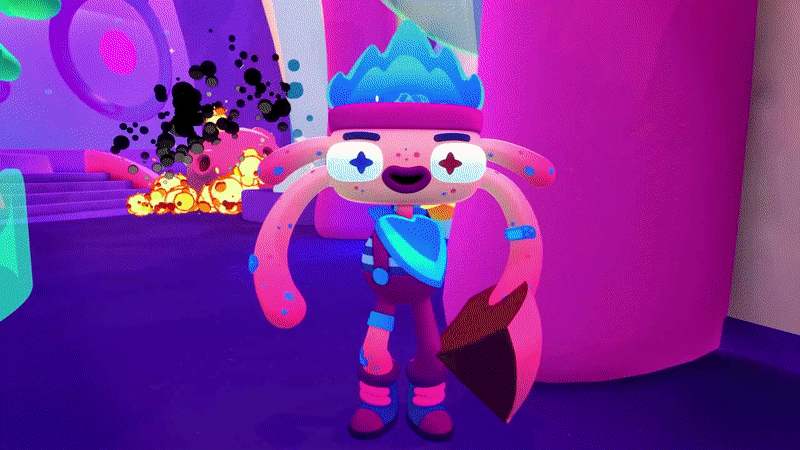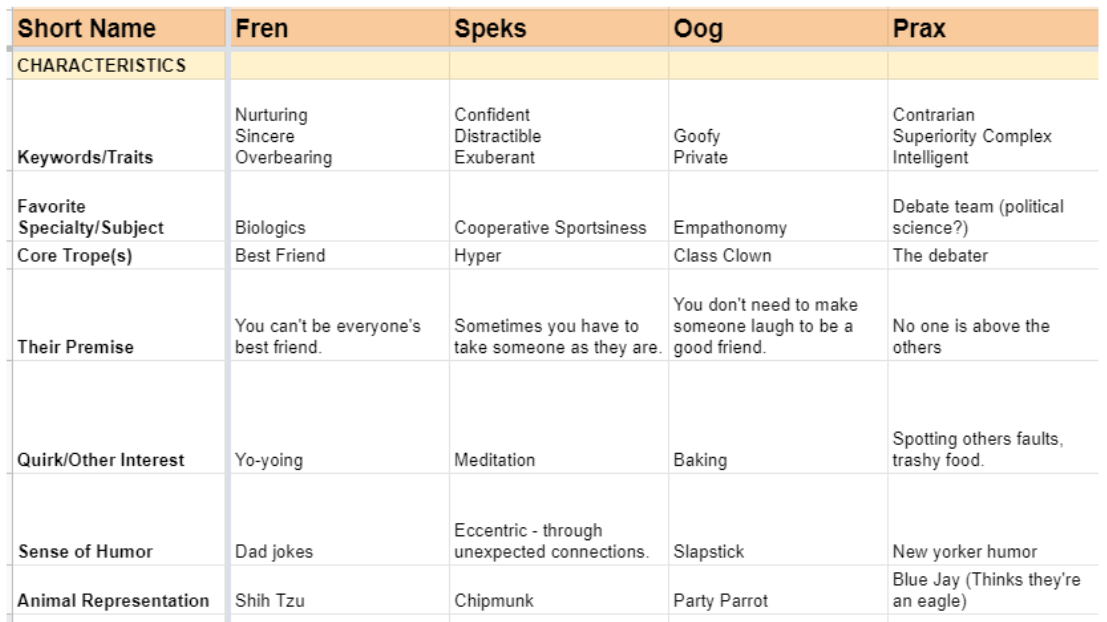
You Love It? Cut It!
Writing & Narrative in Cosmonious High
Cosmonious High has 12 students, 5 teachers, and 1 hyper-intelligent intercom system. All of them needed their own voice, personality, and story arc.
Choose Your Tropes
We started with a company-wide giant brainstorm of our high school experiences. We looked for archetypes that came up consistently: Jock, Goth, Stoner, Wiz-Kid/Smarty, Prep, Artsy, Band Kid, Chameleon, Class Clown, Daydreamer…
From those core tropes, we worked to undermine the negative aspects (optimistic future!) and highlighted the depth and nuance that might not normally be associated with the trope.
A small glimpse of one of our early character design spreadsheets
We also tried to summarize the arc of their story in a single sentence and used that as an anchor throughout development. And, of course, we always tried out a few sample lines.
“When we got team members saying they felt "too seen" by a character's dialogue, we knew we were on the right track.” - Hanna Brady, Lead Narrative Designer
The best played plans…
Not everything worked out right away. Li Tahn and Penk were notoriously hard characters to nail down. Li Tahn was initially portrayed as a standoffish and obsessive character: very into gadgets and living in her own world. The feedback we received in initial playtests was that she was a bit too unrelatable. It’s hard to engage with someone who’s largely dismissive.
We went back to the drawing board with Li Tahn and not only rewrote her dialogue, but tried out new voice prints for her as well. In one, she was bubbly and a bit of an airhead, and in the other she was the intimidating cool kid with unshakeable self-confidence. The cool kid take resonated most with the team and playtesters. She still didn’t say much, but what she did say made players want to know more.
Talk to me, talk to me!
One verb suspiciously absent from our prior Character Design blog was TALK. Players wanted to talk to characters, ask them questions, and respond to their quips. But how do you begin to do that when players don’t have a voice?
We had two big challenges here: the first was platform agnostic and revolved around picking dialogue options, the second was specifically about how to make it a juicy interaction in VR.
Emojis: The Universal Language
We’ve all encountered dialogue previews where we think our character is going to say one thing but the tone or content winds up completely different. And let’s face it: English text just isn’t that accessible when your players are all around the globe and all different ages.
Early on, we decided that the player was going to communicate exclusively through emojis. At first we tried to make up our own set of alien emojis, but ultimately we just wound up using contemporary emojis wherever possible to improve accessibility.
It turned out that an emoji better conveyed tone and intent than any English phrase or sentence, and it upheld our company value of VR for Everyone.
Your Bubbles, Madame
In early prototypes, you would pick an emoji bubble and actually physically throw it at someone. We loved a lot about this: we could use velocity similar to volume. If you CHUCKED your emoji at someone it was effectively screaming, and we could even have characters turn and look towards the impact. Plus, it’s just fun to throw things in VR.
But there’s absolutely no real life parallel to this. In VR we’re dependent on players’ existing mental models for how to interact with objects and spaces, and even with heavy tutorialization, tossing emoji bubbles was never intuitive.
Then we tried just grabbing and pulling, and finally reduced it to just grabbing. Sometimes complexity is additive. Sometimes it’s just complexity.
Humor in the 21st Century
We’re in the midst of massive learning as a society. Things like systemic racism and intersectionality, unconscious bias and equity are being talked about actively and openly in unprecedented ways. As developers, this means we need to be very aware of the jokes we make and how they play into this bigger context.
When we were working on the Back to [JOB] DLC for Vacation Simulator, we wanted to joke about the gig economy. We found out VERY quickly that it felt great to make fun of the system, and terrible to make fun of the people stuck in that system. We could make fun of gig employers, but not gig employees. We could make fun of the powerful, not the powerless.
While the optimistic world of Cosmonious High has a less cynical core, we’re still using humor to poke at teaching conditions and unrealistic expectations on teachers, pressure to succeed and perform on tests, and other aspects of high school life that are enforced on those with less authority. It takes testing and iteration to make sure these jokes land how we hoped, and we definitely don’t always get it right.
In fact, we get a lot of things wrong on the first try.
Blobbert, Jamuel, and Taylin
Recognize those character names? No? That’s because one of our owls rightly pointed out that most of our aliens’ names were just… mashed up white people's names. We were literally making aliens, aliens that could have any linguistic scheme under the sun, and we had defaulted to generic name mashups.
We wound up changing about half of our cast’s names midway through development to address this. Not only to give each species a clear linguistic identity, but to ensure that even the Bipids, who are intentionally human-like, had mashup names from a wider variety of recognizable origins.
Celebrating Everyone
It can also be tempting to have redemptive arcs for certain tropes, but even the idea of redemption implies judgment. Everyone is figuring out who they are in high school, and we wanted to ensure that, no matter who they were, if they were just rocking their own vibe, they would be celebrated.
”We wanted to be careful not to make characters 'fixable'. Our most shy character opens up a little, but doesn't stop being shy. Because, hey, shy is a fine way to be.” - Hanna Brady, Lead Narrative Designer
Feeling over Function
Another lesson we learned late in development was what writing mattered most. We prioritized our main story--the mandatory core path that every player would see from beginning to end. But you know what made the biggest impact on playtesting?
Ambient dialogue.
That’s right! Just characters shooting the breeze with each other, whether it was in the hallway, in a classroom, to a group, or muttering to themselves. Ambient dialogue created a liveliness in the spaces that actually made the game feel like a school. Sure, it’s always fun in games to be the hero, but when all of the dialogue was only about what was going wrong and what you had to do next, it felt dissonantly player-centric. With ambient dialogue the experience was no longer about you saving the school, it was about you experiencing a school and saving it with your new friends.
Cut cut cut
No article on writing or narrative would ever be complete without emphasizing, re-emphasizing, and screaming to the heavens that it is a deeply iterative process that involves constant revision, re-writing, and cutting.
Most classroom story arcs had 4-7 initial story outlines. One was picked, different versions of it were written, and only one of those moved forward. That final sequence of events was trimmed, given a characterization pass, given a humor pass, and then put into game. Once in game, most content received some form of edit or tweak every two weeks to bring it more in line with player feedback.
No, seriously, cut!
Add onto these general practices the fact that in VR players are even freer to wander away, get distracted by something else, or just straight up not listen to what’s being said, and brevity becomes absolutely vital. Even when dialogue is at a point where it’s clear to players, funny, and well-paced, we still do a final pass to see if there’s any way to cut it down or punch it up.
Next blog, we’ll take a deeper dive into just what those classes and assignments look like.







